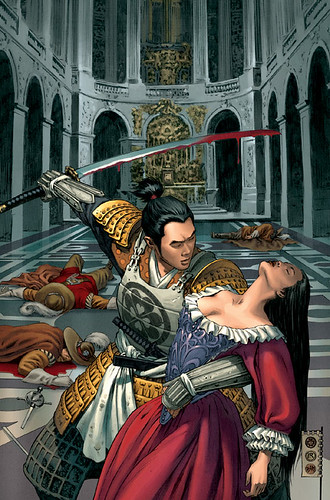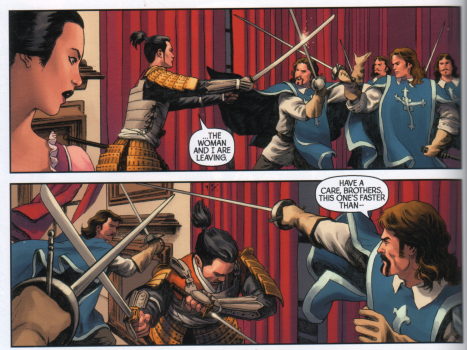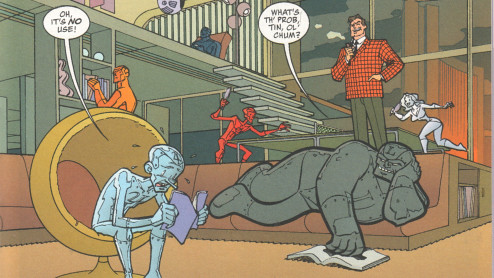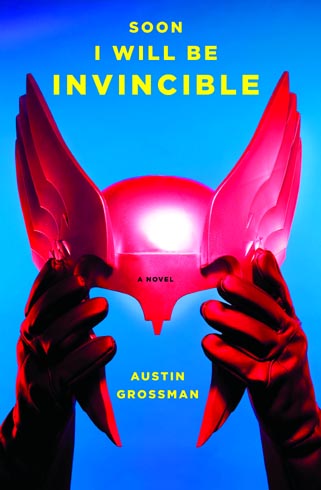
Samurai: Heaven and Earth
by Ron Marz, Luke Ross, Jason Keith, and Dave Lanphear
Dark Horse: 2006
1. Shiro, a samurai in 1704 Japan, loses his beloved Yoshi during the final battle between his master and Chinese warlord. Finding she has been abducted, he follows her trail first to China, and then westward along the Silk Road, eventually finding her in France, at Versailles, in the Court of Louis XIV. Adventures, of course, ensue as he attempts to reunite with her.
2. Yojimbo Meets the Three Musketeers is such an inherently cool high concept that I can forgive the historical inaccuracy of placing the story eighty years after the heyday of Dumas's heroes, one Louis later, and yet still featuring the famous quartet.
3. While the French swordsmen are not named, in dialog and affect they are clearly Athos, Porthos, Aramis, and D'Artagnan. It is actually my third-favorite realization of the characters, after Dumas's own and the 1973 Richard Lester film.
4. Ron Marz's script is engaging, merging classic tropes and fresh ideas seamlessly. His dialog varies between old-movie formality (not a bad thing) and real-sounding naturalism a little less smoothly, however.
5. One small sticking point in the story is Shiro's preternatural ability to learn languages, which is never adequately addressed or given background. We just have to accept it, and since the story won't work unless the protagonist can speak French, we sort of just do.
6. A bigger flaw in the plot is the apparent maintenance of Yoshi's virtue throughout her abduction. We know she is not a virgin even at the beginning of the story, so the "keeping her unsullied to maintain her high value" trope is out; without it, it would be hard to imagine her not being sexually abused, given her circumstances, no matter how "disagreeable" she is to her captors. And since the love between Yoshi and Shiro is what drives him to cross Heaven and Earth for her, it's hard to imagine this aspect would not come up, but the book basically asks us to ignore it. And, once again, in the moment, we sort of just do.
7. Luke Ross's art is just gorgeous: his set pieces, landscapes, and establishing shots are are like museum-quality oil paintings, but he's not afraid to get "comicky" and use technique to advance the story. His attention to detail might be responsible for sucking some of the dynamism out of his action sequences at times. Jason Keith's colors are wonderfully rich and textured and complement the graphics nicely.
8. One technique that Ross used involved a two-page sequence combining one large, borderless image that establishes the action with a couple dozen small panels that shows its progress. Oddly, he uses this format twice: once to depict Shiro and Yoshi making love, and once for a bloody battle. I found the juxtaposition jarring, but I don't know if it was deliberate or if I would even have noticed had I read monthly magazines rather than a collection. (Another unintended consequence in the shift away from serial narrative.)
9. Ross also occasionally uses that photshoppy blurring business I have been seeing in comics lately. Maybe I'm just a geezer, but I don't like it much.
10. The collection features several pin-ups, in styles from cartoony to faux-Japanese print. I liked them, but wanted to see more other characters besides Shiro.
11. The other special feature was a sketchbook, which includes some unused cover designs. I found this section particularly instructive.
12. Volume Two of Samurai: Heaven and Earth follows Shiro to North Africa to confront the slave trader who abducted Yoshi (and some other no-goods, I am sure). I'm certainly going to pick it up.





